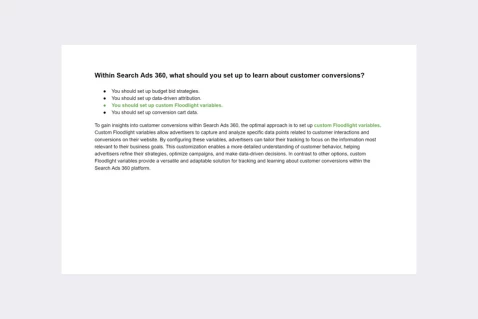Your customer, a purveyor of office supplies, wants to know where to apply labels within their Search Ads 360 campaign. What do you tell them?
You tell them that labels can be applied to bid strategies, campaigns, keywords, and ads.
You tell them that labels can be applied to ad groups, campaigns, keywords, and ads.
You tell them that labels can be applied to ad groups, campaigns, bid strategies, and ads.
You tell them that labels can be applied to bid strategies, dimensions, campaigns and ads
Certification program: 👉 Google Search Ads 360 certification exam
Explanation: You would advise your customer that within their Search Ads 360 campaign, “labels can be applied to ad groups, campaigns, keywords, and ads.” This comprehensive application of labels allows for a flexible and organized approach to campaign management. By applying labels to ad groups, campaigns, keywords, and ads, advertisers can categorize and group elements based on specific criteria or themes. This facilitates streamlined organization and efficient tracking of performance metrics, making it easier to analyze and optimize different aspects of the campaign. The flexibility in applying labels across various campaign components ensures that advertisers can customize their labeling strategy to align with their specific goals and requirements in the Search Ads 360 platform.
Passing exams is not a workout. Multiple attempts won’t make you stronger.



- All possible Search Ads 360 certification exam questions with answers, and explanations.
- Real certification exam questions
- Detailed answer explanations.
- Reflects exactly the latest real exam questions.
- Free lifetime updates.
When it comes to optimizing a Search Ads 360 campaign for a purveyor of office supplies, applying labels strategically can significantly enhance campaign management and performance. Labels serve as customizable markers that allow advertisers to categorize and organize their campaigns, ad groups, keywords, and ads based on specific attributes or criteria. By applying labels effectively, the customer can streamline workflow, monitor performance, and implement targeted optimizations more efficiently.
One key area where labels can be applied within the Search Ads 360 campaign is to categorize different product lines or types of office supplies. For example, the customer can create labels to distinguish between categories such as "office furniture," "stationery," "technology products," and "printing supplies." By assigning these labels to relevant campaigns or ad groups, the customer can easily track performance metrics for each product category and tailor bidding strategies and ad copy accordingly.
Another valuable application of labels is to differentiate between high-priority and low-priority campaigns or promotions. For instance, the customer can apply labels such as "top sellers," "seasonal promotions," or "clearance items" to highlight campaigns that require special attention or have specific performance goals. This allows the customer to allocate resources effectively, prioritize budget allocation, and implement targeted optimizations to maximize ROI for key initiatives.
Furthermore, labels can be used to track performance across different geographic regions or target audiences. For example, the customer can apply labels such as "local market," "national campaigns," or "B2B vs. B2C" to segment campaigns based on target demographics or geographical targeting settings. This enables the customer to analyze performance variations across segments, identify opportunities for optimization, and tailor advertising strategies to specific audience segments more effectively.
In addition to campaign management and performance tracking, labels can also facilitate collaboration and communication within the customer's organization. By applying descriptive labels that provide context or instructions for each campaign or ad group, the customer can ensure clarity and consistency across teams responsible for managing and optimizing the Search Ads 360 account. This fosters efficient collaboration, reduces errors, and streamlines decision-making processes.
In summary, applying labels within a Search Ads 360 campaign for a purveyor of office supplies offers numerous benefits, including improved campaign organization, enhanced performance tracking, targeted optimizations, and streamlined collaboration. By strategically implementing labels to categorize products, prioritize campaigns, segment audiences, and facilitate communication, the customer can optimize their advertising efforts and achieve greater success in promoting their office supply offerings.
Discover our best-value guides
- Special Bundle Offer Google_Ads_Roll
- Special Bundle Offer HubSpot_Exams_Roll
- Special Offer Unchained_Guru_Roll
- Special Bundle Offer Amazon_Roll
- Special Bundle Offer Google_Analytics_Roll
- Special Bundle Offer Google_SkillShop_Roll
- Special Bundle Offer Marketing_Platforms_Roll
- Special Bundle Offer Microsoft_Advertising_Roll
- Special Bundle Offer YouTube_Roll
- Special Bundle Offer Google_Android_Roll
- Ultimate PMP certification preperation guide
- Google Cloud Professional Architect Certification Exam Answers - Ultimate Guide
- Special Bundle Offer SEMrush_Roll